Newberry Library
Life Span: 1893-Present
Location: State and Walton streets
Architect: Henry Ives Cobb
Chicago Sunday Tribune, November 12, 1893

The Newberry Library Building is completed. North Side people who have watched the growth of the beautiful structure with pride and satisfaction the last two years will be glad to know that the work of transferring the books from their modest, temporary quartets on the corner of State and Oak streets to their permanent home on Walton place will be begun next week. It is such a home as even the richly bound vellum volumes and rare old illuminated missals, which are the gems of the Newberry collection, must take pleasure in, although they, like all other patricians, have a right to be ag little particular in zhe matter of their abode.
Almost every Chicagoan is familiar with its location. The lot on which it stands faces the pleasant little park known as Washington square, and in the summer time readers will have through the open windows such glimpses of waving trees and green grass as will make them almost ready to exchange musty books for country pastimes. Imposing as the present structure is, it is really only the south wing of the building. The lot extends 318 feet on Clark street and Dearborn avenue and 212 feet on Oak street and Walton place. As the years roll on and Chicago’s population increases the number of books will naturally grow. When the reading rooms begin to show signs of being crowded it is the intention of the trustees to continue the building around the other three sides of the lot, leaving an open court in the center, thus providing ample room for over 4,000,000 volumes. But this will not take place for many years. Meantime Chicago people who love books will be more than content with what has already been provided.
The style of the building, which was designed by Henry Ives Cobb, is Spanish-Romanesque. The massive pile covers an area of 300×60 feet, or nearly half of an ordinary block. Granite from Branford. Conn., has been used in the construction, its warm brown tones lending themselves with results to building purposes of this nature. The effect of two materials has been given thus stone, however, by using for the foundation and first story rough block and for thle three upper stories smooth cut stone. The first Story is severely plain. Only above its line does the building blossom out into ornamentation. There about the windows and in long lines on the facade the stonecutter has Wrought delicate designs in the rough material that suggests strongly the features Of Moorish architecture. An unusual number of windows tells even to those who view the structure fromn the outside the story of the fine light afforded every room In each of the four stories. Besides serving the purpose of supplying the library with plenty of sunshine and fresh air the with the traceries about them, are a distinctly artistic feature. The entrance is in the form of a triple arch of stone cut in designs and supported by pillars of granite. A broad flight of steps leads up to this from the street. The great oak door by which gains access to the building is placed in the center arch and opens into a square hall of polished Tennessee marble.
Inside the finish is in harmony with the beauty of the exterior. The upper rooms are Wainscoted with Tennessee marble. The basement floor is concrete, the main floor is white marble, and the floors in the upper stories are of red tile. Most of the window casings and all the wainscoting are of marble, scarcely any wood being used in the construction, so that the structure is almost absolutely fireproof. While the stairs are white marble the railings are of iron and exceedingly ornate, grace and being combined with strength and durability. Electricity is used for lighting and steam for heating. both being supplied by the Edison company from a plant located on the same lot. In the basement are revolving fans or blowers which communicate fresh air through shafts to every room in the building, so that heat and ventilation can be regulated its desired. Access from the basement to all the upper floors is had by main and rear staircases, two passenger and one freight elevator, so that convenient communication is amply provided for.
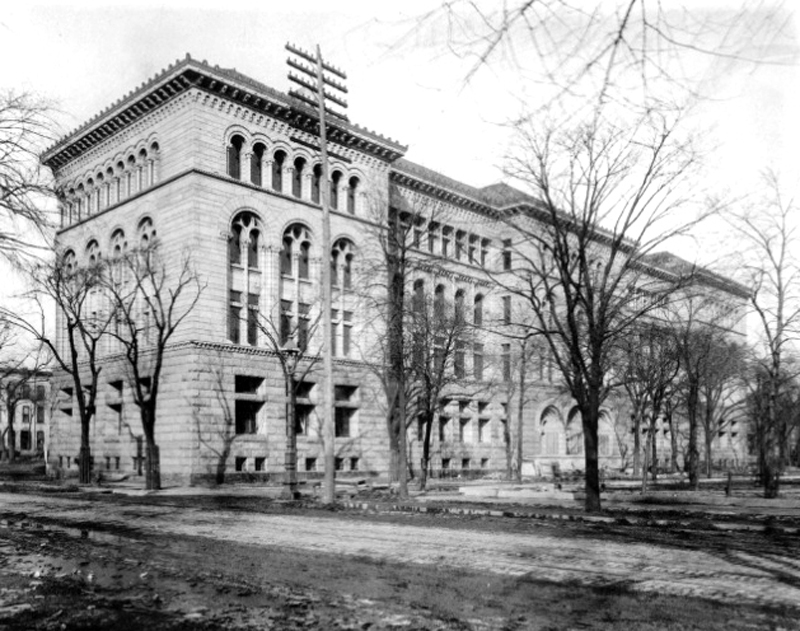
The Newberry Library
Inland Architect and News Record
1893
The design of the Newberry Library is entirely unlike that of other library buildings, of which are of Gothic or ecclesiastical style, reminiscent of the middle ages, when the church was the sole patron of architecture as well as literature. The plans were adopted by the trustees and architect because they seemed to avoid the numerous faults to which the conventional library was prone. Among these may be mentioned the great waste in the interior, caused by having a large room from thirty to sixty high, with the books on galleries four or five stories high, forming an almost impossible to heat near the floor without spoiling books on the upper galleries and so arranged as to make a difficult task for assistants to give proper attention to the demands of readers.
In this building there is no such open space but numerous small rooms, of which holds but one class of books, every volume of which can be reached by a person standing on the floor, thus obviating use of galleries or step-ladders. Some of the principal departments or classifications of books are fine arts, mechanic arts, political economy, social science, history, religion, science, and biography. As the volumes increase in number and any department becomes crowded it can easily be subdivided and allowed to occupy two rooms. In each room are tables for the use of students or visitors who wish to consult books in that department. This will prove far more agreeable to the average reader than studying in a large like an open court, where a hundred or more persons are engaged in similar pursuits.
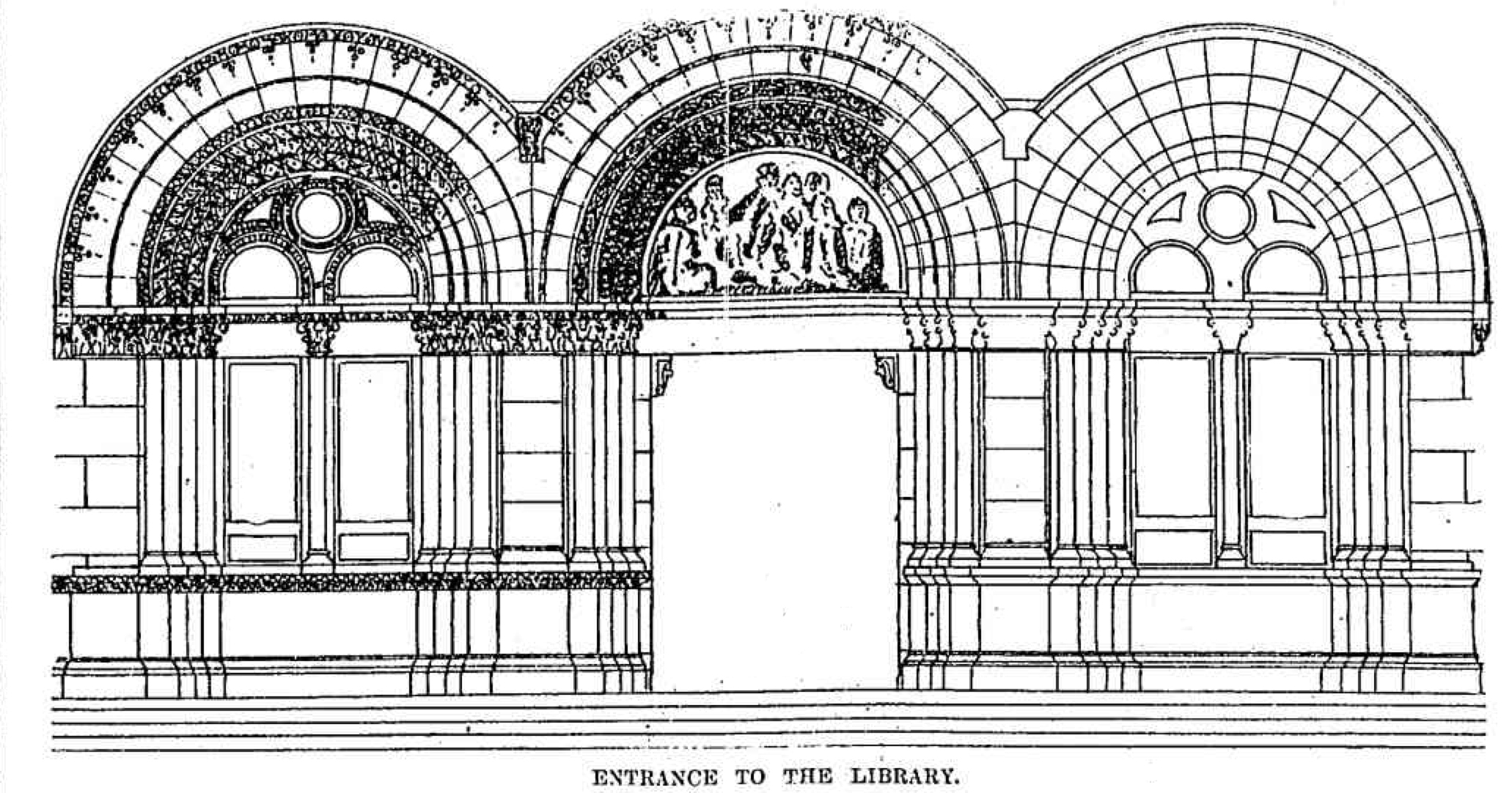
The Newberry Library
Main Entrance
1893
A peculiar feature in the plan is the outside corridor, seven feet wide on each floor, by which access is had to all the rooms. The wall on the inside of the corridors has windows, which admit as much light as possible through the corridor into the rooms. Every room is therefore lighted on two sides.
Few books will be kept on floor. One of the large is to be used as a check-room to keep the wraps and umbrellas of visitors in. In another Mr. Poole will have his desk. This will have no furniture except his chair and “roller-top” and such volumes as lie may select. One thing is sure, these will have fine bindings, and not a few of them will relate to fishing and fishers. For to such things the Librarian of Newberry inclines.
In the Dearborn street end of the big building is a great airy apartment devoted to the cataloguers—those useful, but much abused people who in most libraries have no place they can call their own. At the southwest end of the main floor is an auditorium seating 475 persons. This has been arranged with a special view of carrying on University Extension work, for the library aims at being a live educational center as well as repository of books. Near it on the same floor is the periodical room, which is to bo supplied with nnd tables on which all the important newspapers and magazines in the world will be placed.
Up-stairs is the historical room, 30x5O feet, with a for study 12×30 feet supplied with reading tables. The books are shelved behind a railing in cases eight feet high. The wall cases are deep enough to receive folios and quartos. The cases are double, placed back to back, or open on both sides, and will hold all smaller or ordinary books. The capacity of the room is 27,200 volumes.
Another reading-room on this floor is 161×50 feet. Here the encyclopedias, dictionaries, and bound sets of literary periodicals are to be kept. Here, too, people who desire it can have books brought to them to read.
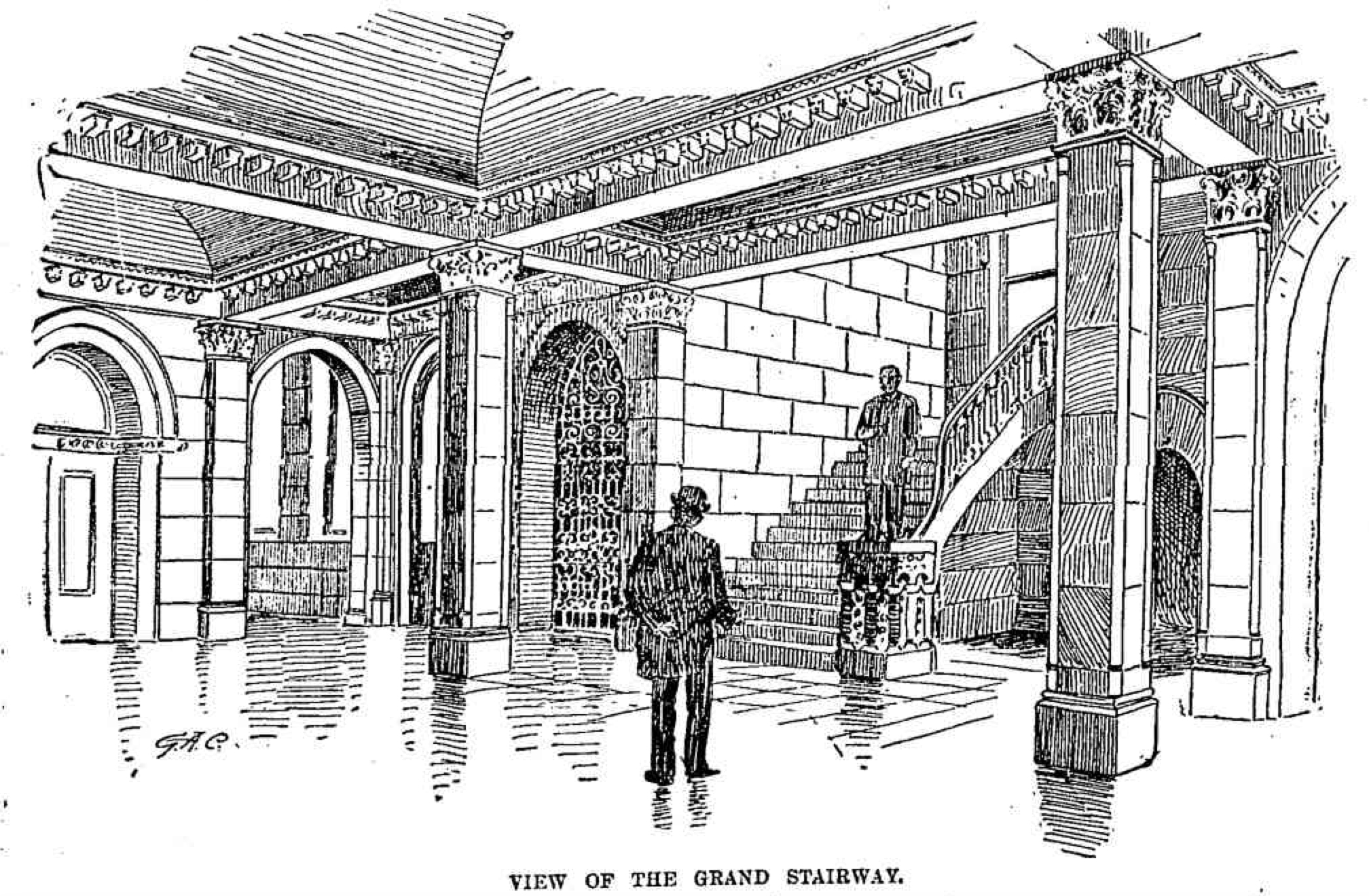
The Newberry Library
Grand Staircase
1893
The Newberry Library is the result of the generous provisions of the will of Walter Loomis Newberry, who died in 1808. By this will he bequeathed one-half of his entire estate to the founding of a free public library, to be located in the North Division of Chicago, the establishing of which should be commenced immediately upon the death of his wife, providing that his two daughters should die without leaving lawful issue. In case either should leave one or more children the entire estate was bequeathed to such heirs. The will was so clearly drawn that its validity has never been assailed. A purely collateral question touching the time for the division of the estate, after one of the severest contests known in Illinois courts was decided against the contestants and in favor of the plain language of the will. Mr. Newberry joined with Mark Skinner in the trust E. W. Blatchford, and later, compelled by his own declining strength, Mr. Skinner left his charge to the hands of William H. Bradley. the two trustees had sole charge of the library, as there was no State law under which they could incorporate.
July 1, 1887, the settlement with the heirs was nearly completed and the income from the library half of the estate was ascertained to warrant the trustees in proceeding to found the library in accordance with the foregoing provisions of the will. Accordingly on that date, as an appropriate tribute to the memory of the founder, the trustees resolved to give to the new institution the name of the Newberry Library, and at the same time decided that it should be a reference library.
July 11, 1887, the trustees decided on a site for the library, selecting the block formerly occupied as the Newberry family home- stead, bounced by Rush and Pine streets on the west and east and Erie and Ontario on the north and south. Two days later the trustees made choice of William F. Poole, LL. D., for fourteen years librarian of the Chicago Public Library, as librarian of the Newberry Library. Dr. Poole accepted the position, and entered upon his duties the 1st of August. Eminently qualified for the place, he has for over six years performed the arduous duties in a most creditable manner. his work having been approved by the best librarians of the world.
June 7, 1889, the trustees purchased of Alfred Cowles for $175,000 the lot on which now stands the new library building, the price being considered at that time as really less than the actual value of the land by at least $45,000. It was not without some misgiving and not until after mature deliberation that the final home for thel library was thus selected. It was approved by the architect, Henry Ives Cobb; the librarian, Dr. W. F. Poole; and Trustees Blutchford and Bradley.

The Newberry Library
First Floor Plan
1893
It was not required by the will that the permanent site of the library should be on the Newberry homestead lot, the only stipulation in that document as to the site being that it “be located in that portion of the City of Chicago now known as the North Division.” The trustees, however, had a desire, to retain the homestead lot for the site, but the new location, in addition to being larger, was in many respects so much better adapted that the change was reluctantly made. The wisdom of the choice has never been questioned.
In addition to being so suitable the Ogden lot is a marked spot in the history of Chicago. It was originally the property of Mr. Newberry, and, as part of his estate, was sold to Mr. Cowles in August, 1861, for $130,000, under thle old Ogden mortgage. The house was for years theMahlon D. Ogden, and, as all Chicago people know, vas the only one in the district which passed unscathed through the great fire. Even the trees upon the lot were unharmed, and some of them are still standing.
Early in 1891 occurred the death of Mr. Bradley, leaving Mr. Blatchford sole trustee with power to appoint his or successor. About this time a law covering the peculiar conditions of the Newberry Library fund enacted at Springfield and Mr. Blatchford concluded to incorporate at once the following twelve residents of Chicago as associato trustees: George E. Adams, Edward E. Ayers, William H. Bradley, Daniel Goodwin, Franuklin 5. Head, Edward S. Ishaim, A. C. AlcClug. Frnaklin MacVeagh, Walter C. Newvberry, Lanibe t Tree, Henry J. Willing, anmd John P. Wilson.
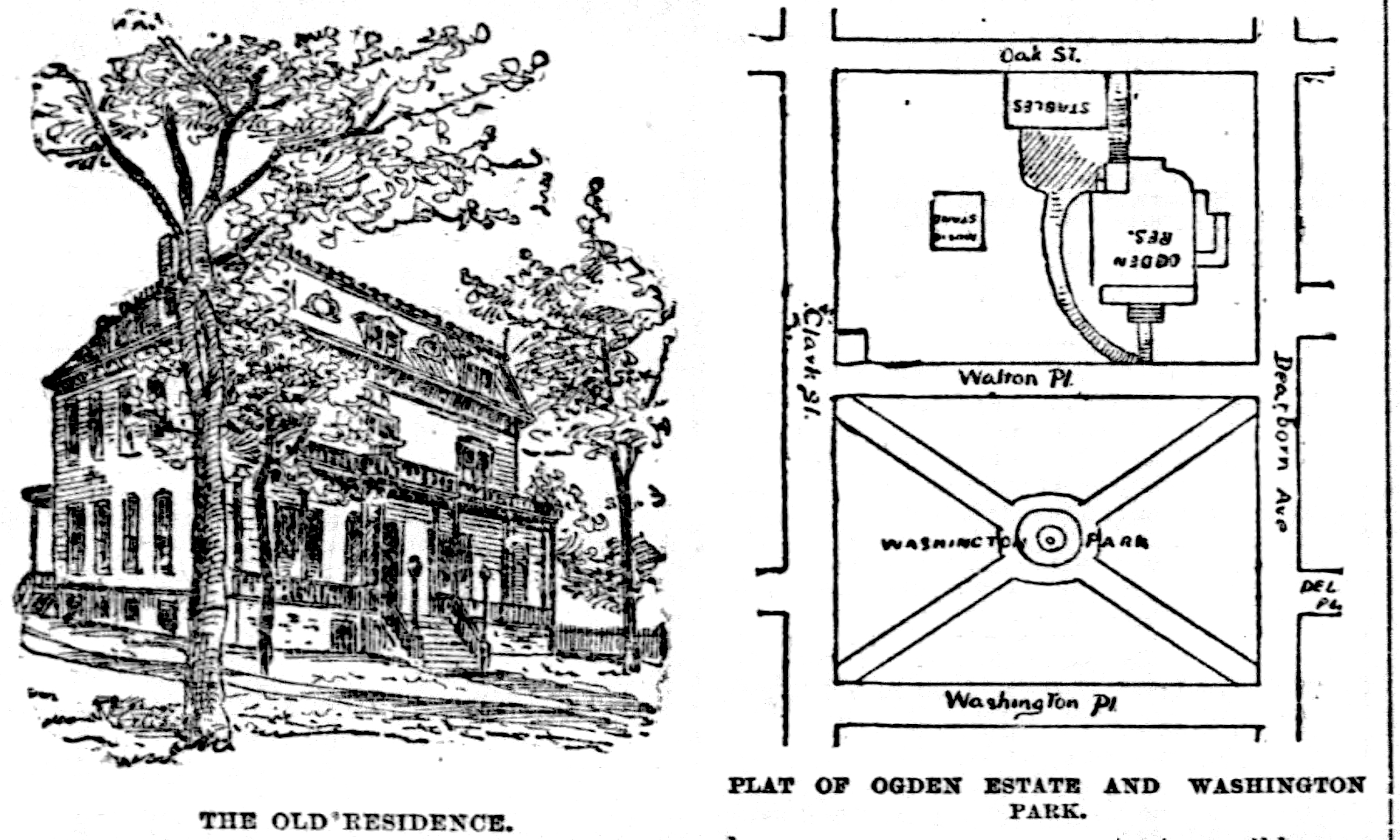
The new Board of Trustees took up the work where they found it and, with the exception of cutting down some of the appropriations had been decided upon, continued the work of the new library building as originally contemplated. The new board wished to retain the income of the property of the estate, and the saving by them of the original plans is thought to be about $100,000.
The first amount scheduled as one-half of the Newberry estate and reserved by the trustees for the and endowment of the library was $2,149,201.00, much of which was in real estate that not only yields a handsome annual sum but has since continually increased in value.
The books acquired by donation and purchase for the first six months of the library, being the last half of 1887, were 6,457 volumes and 4,907 pamphlets. Of these, 359 volumes and 742 pamphlets were donated. The principal purchase was of books on early American and local history, embracing the collections of nearly all the State historical societies in the country, rare serials, the publications of printing clubs, as well as complete works on genealogy, the late Civil War, and Mormonismn. Sept. 6, 1887, the library was located temporarily at No. 90 La Salle street, where furniture and bookcases were arranged, with accommodations for 7,000 volumes.
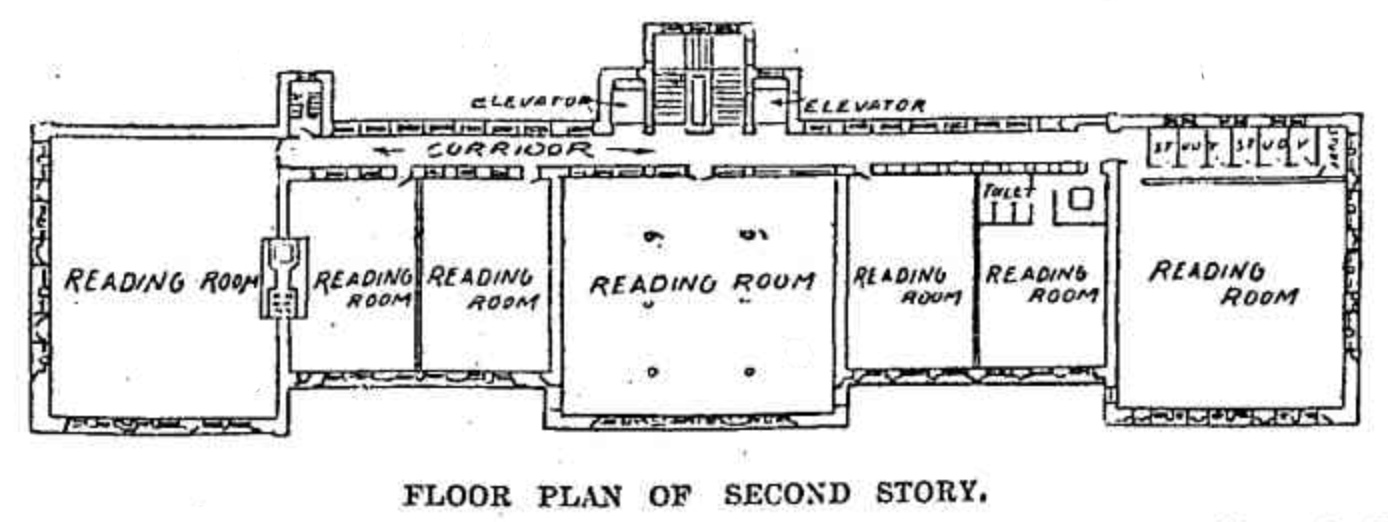
The Newberry Library
Second Floor Plan
1893
The first book given to the library was a copy of the Caxton Memorial Bible, presented Sept. 29, 1877, by the Oxford University Press through the late Henry Stevens of London. it waited in a safe deposit ten years for the library to come into existence. A copy of this Bible, held up by Mr. Gladstone at the Caxton memorial celebration June 30, 1877, the 400th anniversary of the great printer, as “the climax and consummatiOn of the art of printing,” was printed at Oxford, bound in London, and delivered at the South Kensington Exhibition buildings within twelve consecutive hours. The printers commenced to make their preparations soon after midnight, and the printing actually commenced at 2 a. m. The sheets were artificially dried, forwarded to London, folded, rolled, collated, sewed, subjected to hydraulic pressure, gilded, bound, and taken to South Kensington before 2 p. m. The book consists of- 1,052 pages, 16mo., minion type, and is bound in Turkey morocco, beveled boards, flexible back, gilt-lettered on back and inside cover, with the arms of the Oxford in gold on its obverse side. It contains an explanatory inscription and title, “In Memoriam Gui. Caxton,” with the occasion and date of the edition printed at the bottom of each of its thirty-three sheets. The edition was limited to 100 copies, of which the one presented to the Newberry Library is numbered ninety-eight.
During the year 1888 nearly 15,000 volumes were added to the library, which were many musical and medical works, those departments being well filled. At this time the entire musical library of Count Pio Resse of Florence, Italy, was secured. It is composed largely of works by Italian writers on the theory and history of music, including the earliest. One of the most valuable books is the music of .Jacopo Peri’s opera ” Euridice,” known to students of music its the first opera that was ever publicly’ performed. The opera was written for the festivities attending the of Maria de MAedici to Henry IV. of France, and was first performed at Florence Oct. 0, 1600. It was printed in quarto at Florence in 1000, and, bears the dedication to Maria dp MAedici. Nu copy has before been seen in this country, and but one other is known in Europe. The second edition, printed at Venice in 1008, is in the British Museum. Accompanying this volume is the original libretto of “Euridice,” written by Ottavio Rinnecini, and printed at Florence in 1000.
The year 1889 was characterized by wonderful advancement of the library. Over 10,000 volumes were added, making 37,375 then on hand, besides 12,349 pamphlets. During the year there was expended for books and binding $38,018.55, besides $12,704.48 for salaries and incidental expenses.
During 1890 still greater progress was made, nearly 24,000 volumes being added to the library at a cost of $84,258.40, with over $10,000 expended for salaries and other current expenses.
Henry Probasco of Cincinnati presented many valuable gifts at the time his large collection of books purchased. Sonic of thie most valuable of these are as follows: Marble bust of Henry Clay, taken in his prime, by Joel T. Hart; copy of a bust of Dante, by Domenico; bust of Shakespeare, made from the wood of the “Hearne’s Oak,” England; autograph letters of Napoleon I., Frederick the Great, and Meyerbeer; copy of Gregorii Nazianzeni opera, 1570; nineteen Latin manuscripts in parchment, relating chiefly to the Convent of St. Geronima de la Murtrn, with Papal bulls, etc., of dates from 1404 to 1641; ten Spanish manuscripts on parchment, one being a Grant of Absolution, made Oct. 13, 1487, by Don Ynigo Manrique, Archbishop of Cordova, to Don Diego Fernandes de Cordova, Count of Cabra. and to the monks of the Monastery of Santa Maria de Consolacion. with bull of Innocent VIII., dated April 26. 1487, incor- porated in the document; Perpetual Annuity, granted Feb. 1, 1649, by Philip IV., and deeds of sale, grants and perpetual leases to property in Cordova of dates from 1488 to 1619.
In April, 1886, the trustees received notice that George P. A. Healy, the artist, had decided to bequeath to the library a valuable portion of his collection of paintings from the walls of his studio in Paris.
In April, 1890, the library was removed from No. 338 Ontario street to thle northwest corner of North State and Oak streets. At the close of that year the number of volumes hand increased to 60,014 and pamphlets to 23.958.
The Medical Library Association of Chicago had been incorporated with a view of establishing a complete library, but. finding itself unable to accomplish the undertaking, donated all its books during the year to the Newberry Library. The trustees accepted the gift and assumed the responsibility of continuing the work successfully. On consideration of payment for the additions made to its works by the Chicago Public Library, that institution donated all its volumes in this department to the Newberry Library. These two valuable collections amounted to 8,098 volumes and 6,459 unbound serials and pamphlets. This department has since been largely added to, so that it is now so complete as to be highly valued by the medical fraternity and frequently consulted.
The present number of bound volumes is over 117,000, and there are 40,000 pamphlets. When in the new and commodious structure, where there will be no longer lack of room, the increase of books will be much more rapid. In the basement it is the intention of the trustees to establish a bindery, so that the work can be done on the premises, thus saving cost of carting books to a bindery and back again.
Books are not circulated from the Newberry Library, but are used only on the premises for study and reference. The purpose of the library is to meet the higher wants of scholars rather thans the demands of readers of literature. Persons who wish to see the latest sensational novel go elsewhere. The use of books is free to all comers, whether they be residents of Chicago or of the Pacific coast. No tickets or letters of introduction are required.
The departmnent of biography is large and complete. Another one is a collection of the sources of American history, including biography, genealogy, State and local town histories, the publications of historical societies, books on the War of the Rebellion, the Revolutionary and other wars, together with the political and constitutional histories of the Nation and the individual States. The department of music is the largest and best in the country, and for its completeness the musical profession is largely indebted to Georgo P. Upton, vho compiled the original list for purchase and has gratuitously given the library the benefit of his knowledge one of the best musical literature. The collection contains the entire scores of all the great masters in the best editions.
The library recently bought the very interesting collection of books on fish and fishing by Robert Clarke, the veteran publisher of Cincinnati, which numbers about 1,000 volumes in elegant bindings. It is the largest fishing collection in the country. Mr. Clarke was forty years in making it.
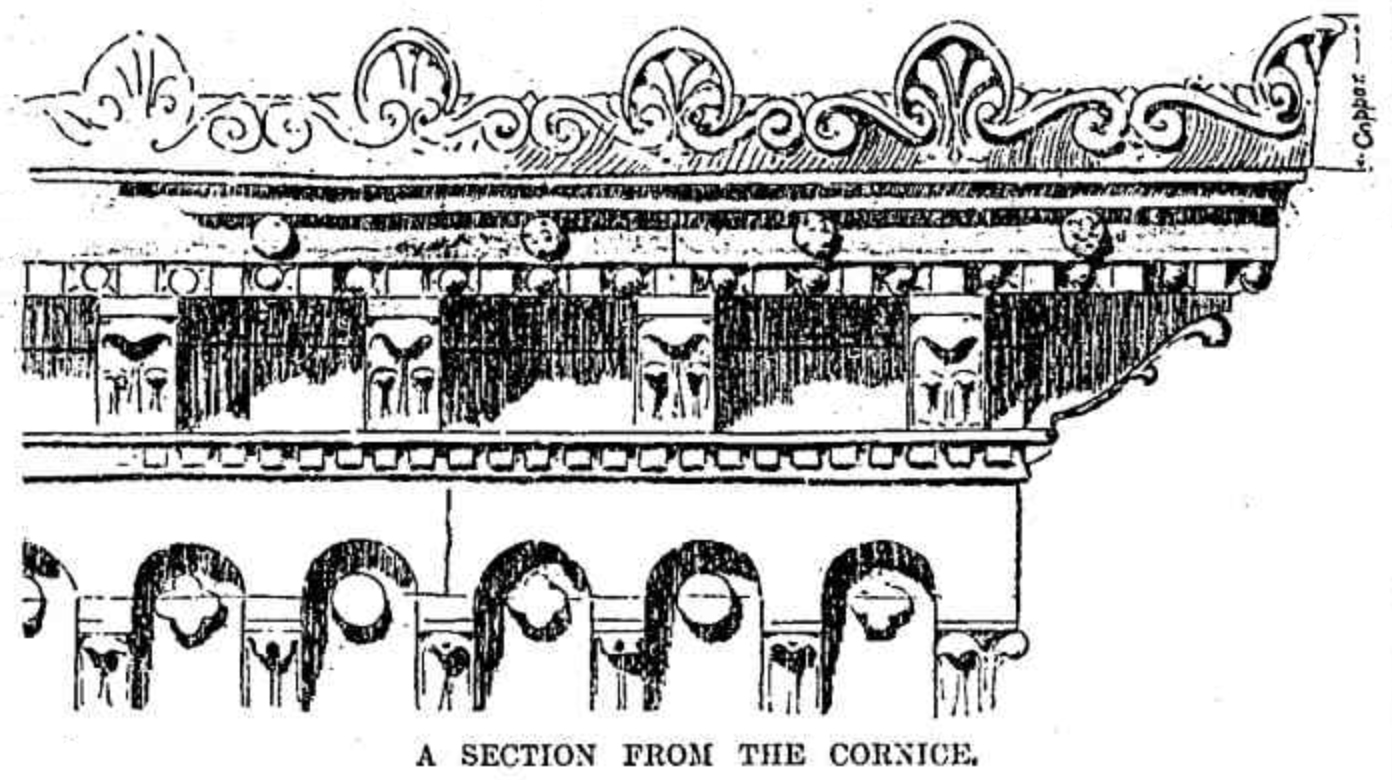
The Newberry Library
Section of the Cornice
1893
The most interesting single collection in the library is the one of early books and manuscripts purchased by Mr. Henry Probasco of Cincinnati, several years ago. Having large means it was his to own the early editions of the English Bible, the earliest impression of the works of the greatest authors in literature, and specimens of typography made before the year 1500. His leading taste as a collector was in procuring the finest art bindings from the time of Grolier to that of Trantz-Banzonet and Bedford. The collection shows the work of about seventy of the greatest art-binders, and the progress in book binding from the sixteenth century to our time. It has twd Groliers (1550-1505) stamped on the cover, “Ia. Grolierii et Amicorum,” described in Le Roux de Liney’s “Recherches sur Jean Grolier,” and have Grolier’s autograph inside their covers. The Italian, Spanish, and French art of each century are shown, and those with the English of the century are superb. Of the Fremich binders it shows of Bozerian five specimens. Capé twenty-nine, Chambolle-Duru six, David sixteen, Duru eight, Hardy eight, Hardy-Alennil thirty-four, Koehler eight, Lortie eight, Niedrée thirteen, Petit eight, Simier ten, Prautz- Bauzonet thirteen. The collection of art bindings will be chronologically arranged and exhibited under glass, so that the styles can be studied by periods. countries and individuals.
The collection of bibles is very rich. Of the English bibles it has the “Great Bible,” 1539; Cranmer’s” 1541; “Matthews, “John Rogers’ Revision of Coverdale,” 1549; “Jugge’s Revision of Coverdale,” 1565;”,The Bishops,” 1555,; “Geneva Vernie,” 1609; the first edition of Ring James’ version, “He Bible,” 1611; and thim second edition, the same year, called the “She Bible.”
Of Shakspeare there are in the library the four early folios, 1623, 1632, 1664, 1685: of Homer the editions beginning with that of Aldus, 1517; of Dante, nine editions, from 1477; of Horace, eight editions, from that of Aldus, 1519, anid of Petrarch, eleven edi- tions, from 1475 to 1732. It has the folio editions of Audubon’s ” Birds mnd Quadrureds “and of Lipsius’ “Egypt.” Its illuminated manuscripts of the middle ages are very fine and will also be placed on exhibition under glass. The exhibition room, however, will not be ready for some months asid thin interior fixtures and furniture vill not be provided until after the has been moved from its quarters.
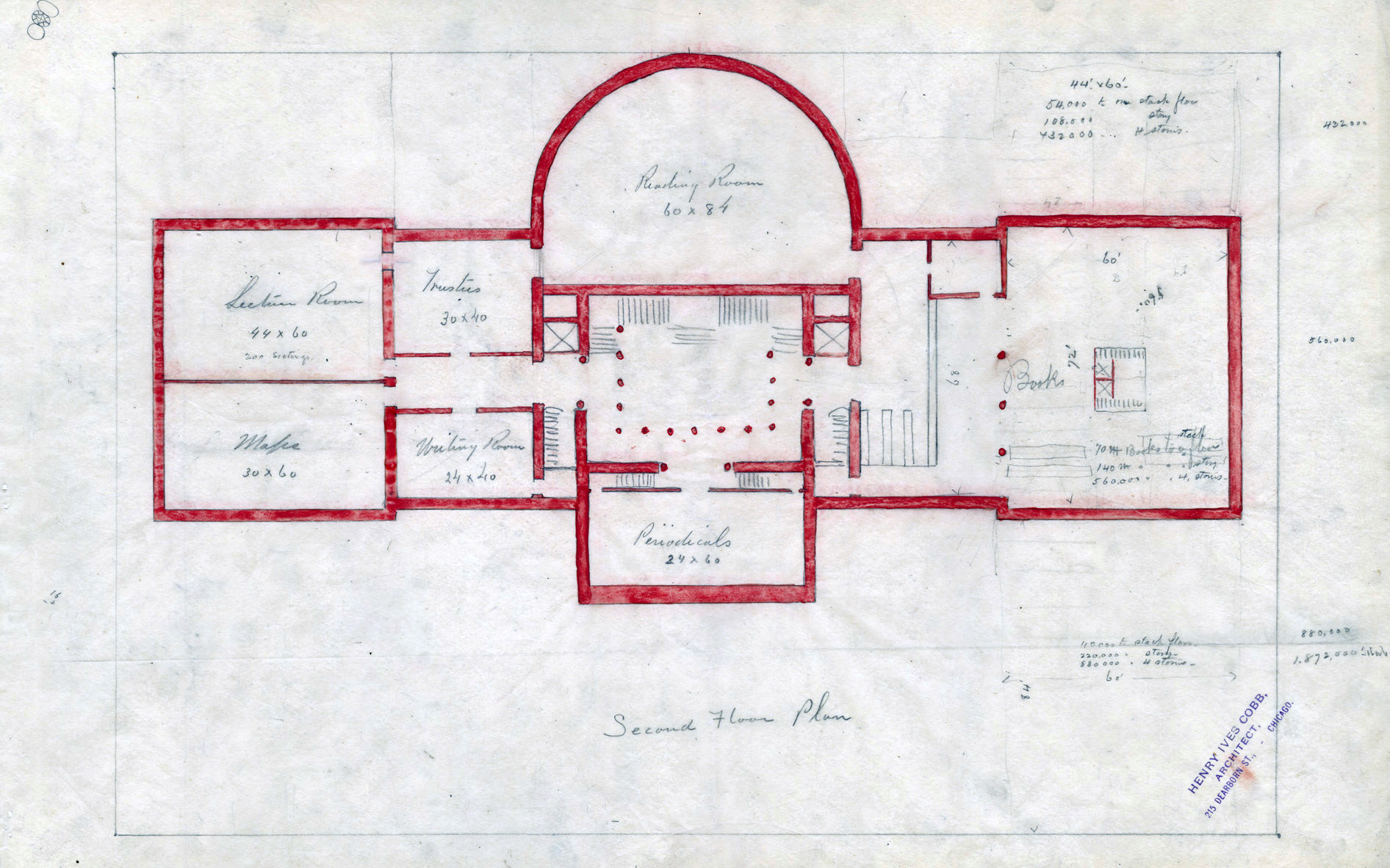
The Newberry Library
Second Floor Plan
1890
Chicago Sunday Tribune, November 12, 1961

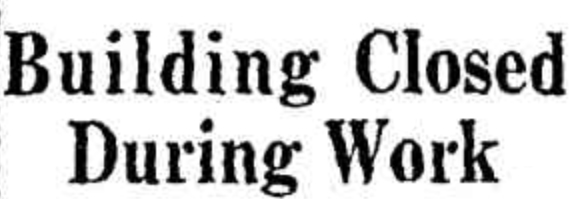
The famed Newberry library building, unchanged on the outside since it was built in 1893, is undergoing a complete interior remodeling program designed to combine the old with the new.
Located on the near north side at Walton place and Dearborn street, the five story stone building, home of a world famous collection of books on the humanities, is closed while remodeling is in progress.
Dr. Stanley Pargellis, Newberry librarian since 1942, gave his staff of 65 a three month vacation while workmen installed a modern air conditioning unit and new heating ducts, put in new lighting fixtures, remodeled windows and doorways, tore out old shelving to make way for new, and plastered or painted nearly every wall in tile building.
Change in Date
“We had hoped to he open by the first of October,” Dr. Pargellis said, “but delays came up. Now we plan to be open for readers by the first of December.”
Dr. Pargellis described the building as “almost an oasis in this rushed world.”
The building s high ceilings and massive interior pillars have remained, for the most part, unchanged. The huge, high windows which catch every ray of sunlight and the wide sloping staircase are as they were when the building was first built.
On the other hand, most of the old wooden shelving is being replaced by less bulky metal shelves. Modern fluorescent lighting has been installed on every floor and almost every room will be outfitted with new furniture.
Rare Book Room
The rare book room has been expanded to hold 250,000 volumes. A vault, such as used in banks, large enough to hold 12,000 books, has been installed in the room. Two new elevators will replace the simple, small elevator now in service. Dr. Pargellis said they will be in service by January.
The lounge for Newberry fellows on the second floor, designed for “afternoon tea and talk,” has been enlarged and will be refurnished. Several smaller, private reading rooms have been added and are designed for use by scholars who spend weeks and sometimes months using the library’s valuable collection.
Dr. Pargellis is expecially proud of the new air conditioning thruout the building.
“This is air conditioning for the books rather than for the people,” he said. ” We will now be able to maintain a constant humidity on every floor. This modern equipment makes the preservation of valuable books much easier.”
Books Not Moved
Not one of the library s 800,000 volumes—some books of which there are few duplicates—has been removed during remodeling operations. Every shelf was covered with sheets of plastic to protect the books from plaster dust. Nevertheless, each book will have to be carefully cleaned, Dr. Pargellis said.
The Newberry library was founded in 1#87. It was established thru the will of Walter Loomis Newberry, a Chicago business man, who left it approximately 2 million dollars when he died in 1868. The terms of his will stated that one half of his estate should become available in 1885 for the establishment and building up of the collection.
Suggestion In 1927
Since its founding there have been several attempts to move the library. Both Northwestern university and the University of Chicago have put in strong bids for the collection to be housed on their campuses.
In 1927, THE TRIBUNE quoted an “authority on near north side real estate,” as calling the library structure “an old dingy building.” He suggested the trustees could lease the site for a combination hotel, office, and store building and move the library to Northwestern university in Lake Shore drive.
Other persons, some of them art experts, have praised the building as a beautiful example of renaissance architecture.